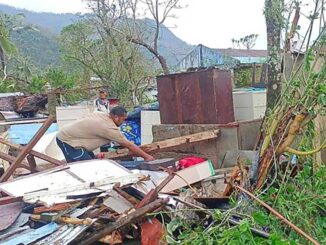
GENEVA, Switzerland — Global childhood vaccination levels have stalled, leaving millions more children un- or under-vaccinated than before the pandemic, the UN said Monday, warning of dangerous coverage gaps enabling outbreaks of diseases like measles.
In 2023, 84 percent of children, or 108 million, received three doses of the vaccine against diphtheria, tetanus and pertussis (DTP), with the third dose serving as a key marker for global immunization coverage, according to data published by the UN health and children’s agencies.
That was the same percentage as a year earlier, meaning that modest progress seen in 2022 after the steep drop during the Covid-19 crisis has “stalled,” the organizations warned. The rate was 86 percent in 2019 before the pandemic.
TOO MANY CHILDREN MISSED A child receives polio and rubella vaccines during the Department of Health’s vaccination campaign against measles and rubella in this file photo. PHOTO BY MIKE ALQUINTO
“The latest trends demonstrate that many countries continue to miss far too many children,” Unicef chief Catherine Russell said in a joint statement.
In fact, 2.7 million additional children remained un- or under-vaccinated last year compared to the pre-pandemic levels in 2019, the organizations found.
‘Off track’
“We are off track,” World Health Organization vaccine chief Kate O’Brien told reporters.
“Global immunization coverage has yet to fully recover from the historic backsliding that we saw during the course of the pandemic.” Not only has progress stalled, but the number of so-called zero-dose children, who have not received a single jab, rose to 14.5 million last year from 13.9 million in 2022 and from 12.8 million in 2019, according to the data published Monday.
“This puts the lives of the most vulnerable children at risk,” O’Brien warned.
Even more concerning is that more than half of the world’s unvaccinated children live in 31 countries with fragile, conflict-affected settings, where they are especially vulnerable to contracting preventable diseases, due to lacking access to security, nutrition and health services.
Children in such countries are also far more likely to miss out on the necessary follow-up jabs.
A full 6.5 million children worldwide did not complete their third dose of the DTP vaccine, which is necessary to achieve disease protection in infancy and early childhood, Monday’s datasets showed.
‘Canary in the coalmine’
The WHO and Unicef voiced additional concern over lagging vaccination against measles — one of the world’s most infectious diseases — amid an exploding number of outbreaks around the world.
“Measles outbreaks are the canary in the coalmine, exposing and exploiting gaps in immunization and hitting the most vulnerable first,” WHO chief Tedros Adhanom Ghebreyesus said in the statement.
In 2023, only 83 percent of children worldwide received their first dose of the measles vaccine through routine health services — the same level as in 2022 but down from 86 percent before the pandemic.
And only 74 percent received their second necessary dose, while 95-percent coverage is needed to prevent outbreaks, the organizations pointed out.
“This is still too low to prevent outbreaks and achieve elimination goals,” Ephrem Lemango, Unicef immunization chief, told reporters.
He pointed out that more than 300,000 measles cases were confirmed in 2023 — nearly three times as many as a year earlier.
And a full 103 countries have suffered outbreaks in the past five years, with low vaccination coverage of 80 percent or lower seen as a major factor.
By contrast, 91 countries with strong measles vaccine coverage experienced no outbreaks.
“Alarmingly, nearly three in four infants live in places at the greatest risk of measles outbreaks,” Lemango said, pointing out that 10 crisis-wracked countries, including Sudan, Yemen and Afghanistan, account for more than half of children not vaccinated against measles.





Be the first to comment